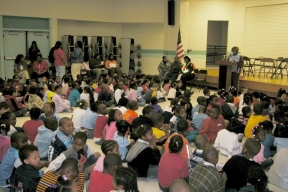Healthy Places - Schools
Schools play a critical role in promoting the health and safety of young people. Children can spend up to half of their day in schools. Healthy students have improved cognitive, physical, social, and emotional development. Healthy schools can establish lifelong healthy behavior patterns. A healthy school is committed to supporting healthy eating, improving physical activity, and providing a safe and nurturing learning environment. The Tennessee Department of Health promotes healthy learning places to support the academic success of students.

Why strive for a healthy school?
Why is physical activity important for children?
How can schools encourage physical activity?
Why is nutrition in schools important?
What is Coordinated School Health?
What is Active Students, Active Learners?
What is the Safe Routes to School Program?
What is a shared used agreement?
What is Child Care Safe Siting important?
How can schools maintain air and water quality?
What is a green school?
What is an outdoor classroom?
Government partners
Additional resources
Helpful documents
There is more information on our TN.gov/HealthySchools Website. Visit for indoor air, drinking water, head lice, green chemistry, environmental literacy and more about Healthy Schools.
Why strive for a healthy school?
The health of students has been linked to academic success. According to the Centers for Disease Control and Prevention (CDC) schools play a critical role in improving the dietary and physical activity behaviors of children and adolescents. Healthy Schools support healthy eating and regular physical activity which can prevent obesity and chronic diseases.
CDC developed nine guidelines for developing, implementing, and evaluating school-based healthy eating and physical activity policies and practices for students. Much more information and resources are available on CDC’s School Health Guidelines webpage including implementation strategies.
Healthy Schools help children and adolescents establish healthy lifestyle behavior patterns that carry into adulthood. Collaborative efforts between schools, government, organizations, and the communities often have the most impact on young people. CDC details The Whole School, Whole Community, Whole Child (WSCC) model on their website. This model provides a strong, unified approach to improve learning and health in schools.
Why is physical activity important for children?
According to the U.S. Department of Health and Human Services, regular physical activity in childhood and adolescent improves strength and endurance. It helps build healthy bones and muscles and control weight. Physical activity can also reduce anxiety and stress while boosting self-esteem. It may even improve blood pressure and cholesterol levels. According to the U.S. Surgeon General, children should get 60 minutes of physical activity each day. Physical activity has many learning benefits for children such as:
Brain function – physical activity can increase concentration and attentiveness in the classroom
Wellness – physical activity can reduce feelings of depression and anxiety and promotes physiological wellbeing
Body weight – physical activity burns calories, which together with a balanced diet, helps to maintain a healthy body weight
Socialization – physical activity provides opportunities to learn social cues and develop interpersonal relationships
How can schools encourage physical activity?
Schools can promote physical activity through comprehensive school physical activity programs, including recess, classroom-based physical activity, intramural physical activity clubs, interscholastic sports, and physical education. Schools can ensure physical education is provided to all students in all grades and is taught by qualified teachers. Schools can also work with community organizations to provide out-of-school-time physical activity programs and share physical activity facilities.
Why is nutrition in schools important?
Schools influence the dietary behaviors of children and adolescents. The health of students is linked to their academic success. Schools can support healthy eating by providing opportunities for students to learn about and practice healthy dietary behaviors. Click to our Food and Nutrition webpage for more about how to get kids to eat more fruits and vegetables at child care and schools and assistance programs that support children with special or financial needs. The CDC has also released research on Healthy Eating Design Guidelines for School Architecture that can promote school environments for to be more conducive to learning about and practicing healthy eating.
What is Coordinated School Health?
The Tennessee Department of Education’s Coordinated School Health (CSH) is an evidenced-based model developed by the Centers for Disease Control and Prevention designed to promote healthy school environments so children arrive at school ready to learn and work towards reducing the obesity rate statewide. In 2006, Tennessee became the only state in the nation with a legislative mandate and state funding to implement CSH in all school districts. Coordinated School Health funding provides each school district with a full time Coordinator, an assistant, and basic materials and resources necessary to develop policies, partnerships, and initiatives designed to advance student health and improve academic outcomes. CSH Coordinators address eight components of school health including health education, physical education, health services, mental health, nutrition services, healthy and safe environment, staff wellness, and community partnerships.
What is Active Students, Active Learners?
The Tennessee Departments of Education and Health are working together to help bring tools, success stories and evidence to education decision makers that illustrate the significant impacts of physical activity on the whole student, particularly academic performance. The Active Students, Active Learners website contains evidence-based materials on the impact of physical activity on reading and math scores, as well as the importance of community engagement, physical education and physical activity before, during and after school. The information is presented in an easy to understand format and includes best practices, tools and resources and research evidence.
What is the Safe Routes to School Program?

Safe Routes to School (SRTS) is a federally funded program focusing on the benefits of children walking and biking to school. It aims to improve safety for children and the community and provide opportunities to increase physical activity. A model program integrates health, fitness, traffic relief, environmental awareness, and safety. Safe Routes to School can be a great way to raise awareness about pedestrian safety around your school and community. Celebrate Walk and Bike to School Day. Your school may be able to apply for funding to participate through the Tennessee Department of Transportation’s (TDOT) Safe Routes to School Program.
What is a shared use agreement?
A shared use or joint use agreement is a formal agreement between two government entities setting terms and conditions for shared use of public property or facilities – in this case indoor or outdoor school facilities. These agreements provide communities more opportunities for healthy physical activity. Some examples of shared use agreements would be:
- Allowing community access to outdoor school facilities like playgrounds or sports fields during non-school hours
- Allowing community access to indoor school facilities like a gymnasium during non-school hours
- Allowing third parties such as youth organizations or sports leagues to operate recreational programs at school facilities during non-school hours
There are several examples of shared use or joint use agreements available online. One good source of more information is ChangeLab Solutions’ Model Joint Use Agreement Resources, another is Robert Wood Johnson Foundation’s Joint Use Agreements, and a third is Safe Routes to School National Partnership’s Shared Use of School and Community Facilities.
Why is Child Care Safe Siting important?

The places where children learn should be safe from pollution. Chemical hazards are often more serious threats for children. According to the Agency for Toxic Substances and Disease Registry (ATSDR), children are more likely to suffer from adverse health effects due to environmental exposure for several reasons, such as:
- Children's developing bodies can be particularly sensitive to toxic exposure during certain critical growth stages, especially when children are exposed to chemicals known to cause developmental effects.
- Children weigh less than adults. As a result, when children and adults ingest or inhale the same amount of chemicals, children receive a greater dose than adults.
- Because children play outdoors more than adults, they are often more likely to come into contact with contaminated soils and to inhale greater amounts of airborne pollutants.
Therefore, the location of schools, day cares, and other child care sites should be assessed for past industrial uses and nearby environmental emissions.
The Agency for Toxic Substances and Disease Registry developed guidance to help communities safely site child care facilities. The guidelines will be available soon. The EPA’s School Siting Guidelines webpage provides voluntary School Siting Guidelines to help school make the best possible siting decisions. The Center for Health, Environment & Justice published their Safe School Siting Toolkit to protect children’s health.
How can schools maintain air and water quality?
Maintaining a healthy indoor building environment is important to educational performance and achievement. A healthy school maintains good indoor air and water quality and protects children from environmental exposures. The U.S. Environmental Protection Agency’s Healthy Schools, Healthy Kids Website provides information and resources for school officials, staff, teachers, health care professionals, parents, and students to help maintain and improve environmental quality in schools. EPA’s website covers topics from air and water quality to chemical management and idling buses.
The EPA’s Indoor Air Quality in Schools webpage provides information and resources to maintain and improve indoor air quality in schools. Proper maintenance of heating, cooling, and ventilation (HVAC) systems is key to maintaining good indoor air quality. Controlling moisture and pests are important to minimize allergens from mold or insects. Testing schools for radon and the use of carbon monoxide detectors near combustion sources like boilers, stoves, or water heaters can protect children and faculty from invisible dangers. Using EPA's IAQ Tools for Schools Action Kit will help ensure good indoor air quality in your school.
School indoor air quality is important for children with asthma. Asthma is an inflammatory condition of the breathing airways caused by triggers such as allergens, irritants, and respiratory infections. Symptoms of asthma include coughing, wheezing, shortness of breath, or rapid breathing. Asthma can be controlled by minimizing asthma triggers in the environment. Keeping classrooms clean and well ventilated will help minimize asthma triggers. As will avoiding the use of harsh chemical cleaners or pesticides. Parents are encouraged to provide the child’s teacher and school nurse an asthma action plan. The Nation Heart, Lung, and Blood Institute has many resources for students, parents, faculty and custodians about keeping schools asthma friendly. The Also visit CDC’s Tools for Asthma Control webpage.
Consuming enough fluids on a daily basis is important for children’s health. Water is a great choice because it doesn't contain the calories, caffeine, or sugar that may be found in other beverages, and water helps nearly every part of the human body function efficiently. Drinking water quality is important in schools and child care facilities. Proper maintenance of a school’s plumbing system is important to having good water quality. Older buildings are likely at higher risk, though water quality should be monitored in all schools and child care settings. Checkout EPA’s Water in Schools site for more information.
If you have a concern about air or water quality at a school or child care facility it is important to share your concern with a local representative such as teacher, principal, custodian or school nurse.
What is a green school?
A green school is a learning institution that reduces environmental impacts to improve learning conditions and lower operating costs. Greens schools are a collaborative effort of students, teachers, parents, and policymakers. Green schools often consider their environmental strategies on topics such as energy use, solid waste generation, indoor air quality, pest management, mold growth, laboratory waste, building renovation, and purchasing, healthy food, environmental stewardship, and sustainability. There are many versions and resources available about green schools. The U.S. Department of Education has a Green Ribbon Schools program recognizes schools, districts, and institutes of higher education that:
- Reduce environmental impact and costs;
- Improve the health and wellness of schools, students and staff; and
- Provide environmental education which teaches many disciplines, civic skills and green career pathways.
What is an outdoor classroom?

Outdoor classrooms follow the principle that children are learning everywhere and all the time. Learning by experience helps children grow in motor development, social-emotional development, language development, and creative expression. Learning outside helps children reconnect with Nature. Outdoor classrooms aim to engage children’s needs and interests through a mix of activities. Outdoor classrooms can increase opportunities for physical activity. Besides, some things can only be learned outdoors.
There are several outdoor classroom opportunities in Tennessee. Project Learning Treeis a program of the American Forest Foundation that uses the forest as a window on the world, engaging the next generation of America's thought-leaders and decision makers. Project Learning Tree provides educators with peer-reviewed, award-winning environmental education curriculum resources that can be integrated into lesson plans for all grades and subject areas. Project WET or Water Education for Teachers provides formal and non-formal educators with curriculum, materials, and training in water education for students K-12. Project WET conducts teacher workshops, develops educational materials, and supports environmental education in Tennessee.
Government partners
Centers for Disease Control and Prevention (CDC)
Healthy Schools, Ready to Learn
www.cdc.gov/healthyschool
Health Impact in 5 years (HI-5) - Safe Routes to School
www.cdc.gov/policy/hst/hi5/saferoutes
U.S. Environmental Protection Agency (EPA)
Healthy Schools, Healthy Kids
www2.epa.gov/schools
Tennessee Department of Education
Coordinated School Health
Active Students Active Learners
SNP Program Enrichment
Other partners
ChangeLab Solutions
Webinar: Health Equity in Schools
www.changelabsolutions.org/publications/the-series_episode-5
Additional resources
National Center for Safe Routes to School
Safe Routes
www.saferoutesinfo.org
National Center for Safe Routes to School
Walk Bike to School
www.walkbiketoschool.org
Tennessee Environmental Education Association
Environmental Education in Tennessee
eeintennessee.org
Tennessee Recreation and Parks Association
Benefits of Parks and Recreation
www.trpa.net
Helpful documents
U.S. Environmental Protection Agency
Sensible Steps to Healthier School Environments
PDF
U.S. Environmental Protection Agency
Development and Implementation of a School Environmental Health Program
PDF
National Association of State Boards of Education
Preventing Childhood Obesity A School Health Policy Guide
PDF
National Heart, Blood, Institute
Asthma & Physical Activity in the School
PDF
National Asthma Education and Prevention Program
Managing Asthma A Guide for Schools
PDF
Voices for Healthy Kids
Safe Routes to School Toolkit
PDF
